Digital Poster
High-Field RF Coils & Arrays II
Joint Annual Meeting ISMRM-ESMRMB & ISMRT 31st Annual Meeting • 07-12 May 2022 • London, UK

| Computer # | ||||
|---|---|---|---|---|
1535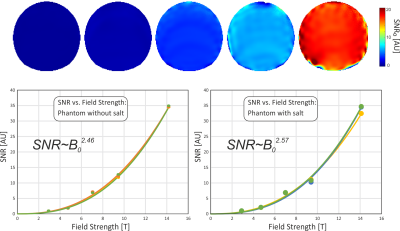 |
85 | SNR and Field Strength with Small Surface Coils
Rolf Pohmann1, Nikolai Avdievitch1, and Klaus Scheffler1,2
1Magnetic Resonance Center, Max Planck Institute for Biological Cybernetics, Tübingen, Germany, 2Biomedical Magnetic Resonance, University of Tübingen, Tübingen, Germany
The increase in SNR with higher field strength is one of the main drivers for ultra high field MRI. Here, the sensitivity gain is determined for phantoms in five different fields between 3 T and 14.1 T, using identical small surface coils and correcting for all scanner specific influences. A strong, more than quadratic SNR gain with increasing field strength was found, which applies to many animal studies and to measurements with weakly loading samples.
|
||
1536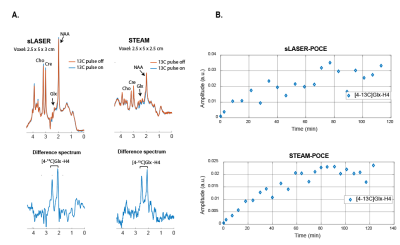 |
86 | Human brain POCE MRS at 7T using a 13C birdcage coil and 8 transmit-receive 1H antennas with a 32-channel 1H receive array
Sarah M Jacobs1, Jeanine J Prompers1, Wybe JM van der Kemp1, Tijl A van der Velden1, Mark WJM Gosselink1, Ettore F Meliadò1, Hans M Hoogduin1, Graeme F Mason2, Robin A de Graaf2,3, Anja G van der Kolk1,4, Cezar Alborahal1, Dennis W Klomp1, and Evita C Wiegers1
1Department of Radiology and Nuclear Medicine, University Medical Center Utrecht, Utrecht, Netherlands, 2Department of Radiology and Biomedical Imaging, Magnetic Resonance Research Center, Yale University School of Medicine, New Haven, CT, United States, 3Department of Biomedical Engineering, Yale University School of Medicine, New Haven, CT, United States, 4Department of Radiology, Radboud University Medical Center, Nijmegen, Netherlands We have shown that it is feasible to perform POCE MRS in the human brain at 7T during a uniformly labeled [U-13C] glucose infusion in three healthy volunteers, using a 13C birdcage head coil combined with 8 transmit-receive 1H antennas with a 32-channel 1H receive array. STEAM-POCE and sLASER-POCE provided similar sensitivity for the [4-13C]-Glx-H4 signals. POCE examinations could be performed in two locations, i.e. the frontal and occipital lobe, in one session, allowing them to be easily merged with 1H MRI. |
||
1537 |
87 | On the Noise Correlation in Receive Phased Arrays
Paul-François Gapais1,2, Michel Luong3, Saadou Almokdad2, Elodie Georget1, and Alexis Amadon2
1Multiwave Imaging SAS, Marseille, France, 2Université Paris-Saclay, CEA, CNRS, BAOBAB, NeuroSpin, Gif-sur-Yvette, France, 3Université Paris-Saclay, CEA, IRFU, DACM, Gif-sur-Yvette, France
The noise covariance matrix is useful for SNR and g-map computation and, with the noise correlation matrix, commonly taken as metrics to characterize decoupling of denser and denser receive arrays. Roemer provided a resistance matrix accounting for noise correlation. In the literature, Bosma defined the noise covariance matrix from the scattering matrix, easing predictions based on electromagnetic simulations or VNA measurements. Here noise correlation is analyzed for 50 Ω power-matched and low-input impedance preamplifiers. As predicted by Bosma, strong coupling does not necessarily imply a high noise correlation, which also depends on the ports impedance matching.
|
||
1538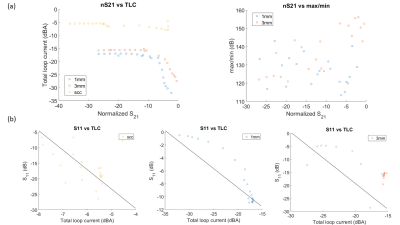 |
88 | Investigation of correlation between surface current and coupling using conventional coils and shielded coaxial cable coils operating at 7T Video Permission Withheld
Giovanni Costa1, Sadri Güler2,3, Peter Baltus1, Maarten Paulides1, and Irena Zivkovic1
1Department of Electrical Engineering, Technology University of Eindhoven, Eindhoven, Netherlands, 2Department of Electrical Engineering, Technical University of Denmark, Kongens Lyngby, Denmark, 3Danish Research Centre for Magnetic Resonance, Centre for Functional and Diagnostic Imaging and Research, Copenhagen University Hospital Amager and Hvidovre, Copenhagen, Denmark
One of the major challenges in the design of multichannel arrays for UHF MRI is minimizing coupling between elements. Shielded-coaxial-cable (SCC) coils have been recently proposed as highly decoupled elements per se: however, the decoupling mechanism of SCC coils is still not determined. In this work, we examined the relationship between coupling, surface current density uniformity, and the total current on coil conductor through measuring and simulating three different 2-coils arrays. While no correlation was observed between surface current density uniformity and interelement coupling, a negative correlation was observed between the coupling and the total current on coil conductor.
|
||
1539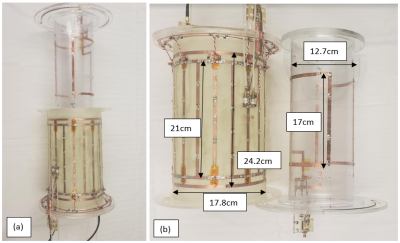 |
89 | Nested Geometrically Decoupled Triple-Tuned Volume Coil for 1H, 23Na and 31P at 4.7T
Joseph Busher1, Edith Valle2, Steven M. Wright1,2, and Mary P. McDougall1,3
1Biomedical Engineering, Texas A&M, College Station, TX, United States, 2Electrical and Computer Engineering, Texas A&M, College Station, TX, United States, 3Electrical and Computer Engineering, Texas A&M, C, TX, United States
The use of traps as well as the use of switching circuitry to develop multinuclear coils is well established. However, it is well known that the use of traps introduces undesired losses to one or more nuclei in the structure while switching eliminates applications requiring true simultaneous imaging. As a result, our group developed a triple-tuned volume coil that solely uses geometric decoupling using only two structures. The coil demonstrated homogeneous fields with sufficient decoupling between the structures to acquire multinuclear NMR data.
|
||
1540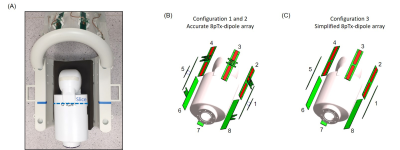 |
90 | Simulation validation of an 8-channel parallel-transmit dipole array: including RF losses for robust correlation with experimental results
Jérémie Clément1 and Özlem Ipek1
1Biomedical Engineering Department, School of Biomedical Engineering and Imaging Sciences, King's College London, London, United Kingdom
A method for validation of the simulation model with respect to experimental results is introduced for an 8-channel parallel-transmit dipole coil array. An original approach to include RF losses is described. The simulation results were quantitatively compared to the experimental data in terms of scattering parameters, individual transmit field (magnitude/phase) and combined transmit field. Two distinct configurations, not including RF losses were compared to the proposed approach. High correlation was achieved between simulated and experimental data. We conclude that with the proposed approach for RF losses, a robust validation is achieved for the 8-channel parallel-transmit dipole coil array at 7T.
|
||
1541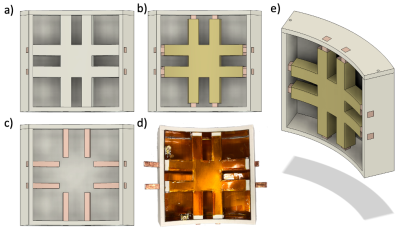 |
91 | Findings during tuning procedure of a 7T radiofrequency transmit resonator Video Permission Withheld
Tiago Martins1 and Tamer S Ibrahim1
1University of Pittsburgh, Pittsburgh, PA, United States In this work, we explain the tuning procedure for a new conforming Tic-Tac-Toe (TTT) array and the findings that were observed during this procedure. These findings help shape how the array can be used in building a 7 Tesla RF coil system for neuroimaging applications.. It is shown that a 2-channel and 4-channel configurations can be tuned similarly and produce similar magnetic field distribution and intensities. |
||
1542 |
92 | Development of 8-Channel 1H-2H Dual-Frequency loop coil array with LC tanks for 1H MRI and 2H MRS imaging of human brain at 7 Tesla
Soo Han Soon1,2, Matt Waks1, Hannes M. Wiesner1, Xin Li1, Xiao-Hong Zhu1, and Wei Chen1,2
1CMRR, Department of Radiology, University of Minnesota, Minneapolis, MN, United States, 2Department of Biomedical Engineering, University of Minnesota, Minneapolis, MN, United States Deuterium (2H) MRS imaging (DMRSI) enables us to measure both the cerebral metabolic rate of glucose and TCA cycle rate and to image brain tumor with an excellent contrast. It is common to apply two sets of 2H and 1H RF coils for performing DMRSI, resulting in coil complexity and RF interference. We introduce an 8-channel 2H-1H dual-frequency loop coil array with LC tanks, enabling each loop coil being tuned to 2H and 1H resonant frequencies simultaneously. We have constructed a prototype head coil for human brain applications at 7 Tesla and validated the coil via benchtop and imaging tests. |
||
1543 |
93 | Noise Considerations for a Microsolenoid at 15.2T Designed for MR Microscopy
Benjamin M Hardy1,2, Yue Zhu1,3, Mark D Does1,4,5, Adam W Anderson1,3,4, and John C Gore1,2,3,4
1Vanderbilt University Institute of Imaging Science, Vanderbilt University, Nashville, TN, United States, 2Department of Physics and Astronomy, Vanderbilt University, Nashville, TN, United States, 3Department of Radiology and Radiological Sciences, Vanderbilt University Medical Center, Nashville, TN, United States, 4Department of Biomedical Engineering, Vanderbilt University, Nashville, TN, United States, 5Department of Radiology and Radiological Science, Vanderbilt University Medical Center, Nashville, TN, United States
Magnetic Resonance Microscopy aims to produce micron scale resolution images in reasonable times, but SNR decreases as voxel sizes shrink. RF coils must be optimized and their performance depends on coil resistance and sample size. We compared the relative performance of a commercially available cryogenically cooled surface coil of 24 mm in diameter to a smaller, 1.5 mm diameter, room temperature microcoil at 15.2T. A silver microsolenoid had threefold SNR increase but with decreased FOV and susceptibility artifacts. An optimized microcoil should be able to produce images with 10 µm isotropic resolution within 10 hours with an SNR of 10.
|
||
1544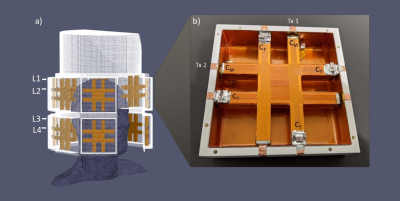 |
94 | Impact of Coupling on the B1+ Field Produced by a 15-panel Tic-Tac-Toe RF Array
Andrea N Sajewski1, Tales Santini1, Anthony DeFranco1, Tiago Martins1, Jacob Berardinelli1, Howard J Aizenstein1, and Tamer S Ibrahim1
1University of Pittsburgh, Pittsburgh, PA, United States
We investigated the impact of coupling (magnitude and phase) on the B1+ field distribution and intensity of a 30-channel double-rowed Tic-Tac-Toe (TTT) RF array. We found that by changing the coupling of the TTT coil modules, we are able to modify the B1+ distribution from a single channel and how the B1+ field intensity is spread between different Z levels of the 30-channel array. This effect was seen in both simulations and experimental B1+ maps.
|
||
1545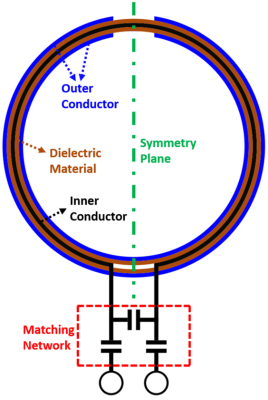 |
95 | Second resonance mode ensure intrinsic low coupling between elements on shielded-coaxial-cable coil designs Video Permission Withheld
Sadri Güler1,2, Vitaliy Zhurbenko3, Irena Zivkovic4, Vincent Oltman Boer1, and Esben Thade Petersen1,2
1Danish Research Centre for Magnetic Resonance, Centre for Functional and Diagnostic Imaging and Research, Copenhagen University Hospital Amager and Hvidovre, Copenhagen, Denmark, 2Section for Magnetic Resonance, DTU Health Tech, Technical University of Denmark, Kgs Lyngby, Denmark, 3Department of Electrical Engineering, Technical University of Denmark, Kgs Lyngby, Denmark, 4Electrical Engineering Department, Technical University of Eindhoven, Eindhoven, Netherlands
The recent introduction of the flexible shielded-coaxial-cable coils (SCC) and their intrinsic high degree of decoupling between elements make them ideal for multichannel transceiver arrays needed for improved field homogeneity at ultra-high field MRI. In this work, we show the mode of operation of the SCC and that the selection of its second resonance mode is crucial to obtain its intrinsic high degree of decoupling between elements. We obtained this insight using both numerical simulations and an equivalent circuit model, which can guide to optimal SCC designs in the future.
|
||
The International Society for Magnetic Resonance in Medicine is accredited by the Accreditation Council for Continuing Medical Education to provide continuing medical education for physicians.